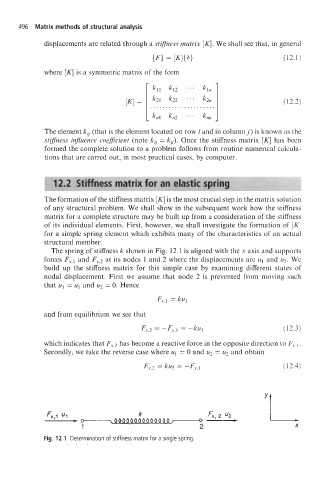Page 515 - Aircraft Stuctures for Engineering Student
P. 515
496 Matrix methods of structural analysis
displacements are related through a stzfjness matrix [K]. We shall see that, in general
{F) = [KI{S) (12.1)
where [K] is a symmetric matrix of the form
(12.2)
The element k, (that is the element located on row i and in columnj) is known as the
stzfness influence coeficient (note k, = kji). Once the stiffness matrix [K] has been
formed the complete solution to a problem follows from routine numerical calcula-
tions that are carred out, in most practical cases, by computer.
:ness matrix for an elastic spring
The formation of the stiffness matrix [K] is the most crucial step in the matrix solution
of any structural problem. We shall show in the subsequent work how the stiffness
matrix for a complete structure may be built up from a consideration of the stiffness
of its individual elements. First, however, we shall investigate the formation of [K]
for a simple spring element which exhibits many of the characteristics of an actual
structural member.
The spring of stiffness k shown in Fig. 12.1 is aligned with the x axis and supports
forces Fx,, and Fx,2 at its nodes 1 and 2 where the displacements are u1 and u2. We
build up the stiffness matrix for this simple case by examining different states of
nodal displacement. First we assume that node 2 is prevented from moving such
that u1 = u1 and u2 = 0. Hence
FYJ = ku1
and from equilibrium we see that
Fx,2 = -Fx,l = -kul (12.3)
which indicates that FY,2 has become a reactive force in the opposite direction to F.Y,l.
Secondly, we take the reverse case where u1 = 0 and u2 = u2 and obtain
( 12.4)
FY,2 = kU2 = -&1
Fig. 12.1 Determination of stiffness matrix for a single spring.

